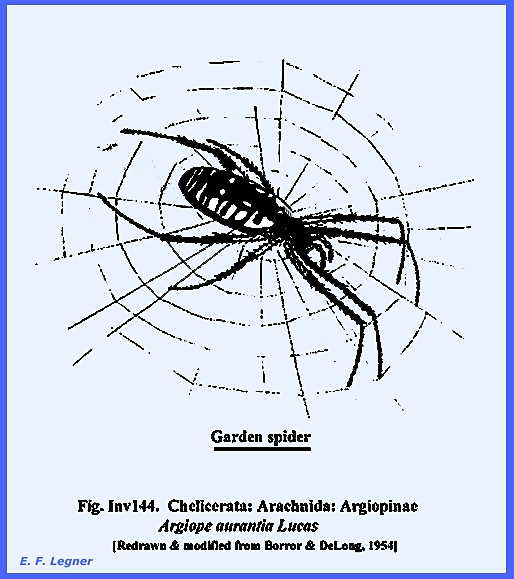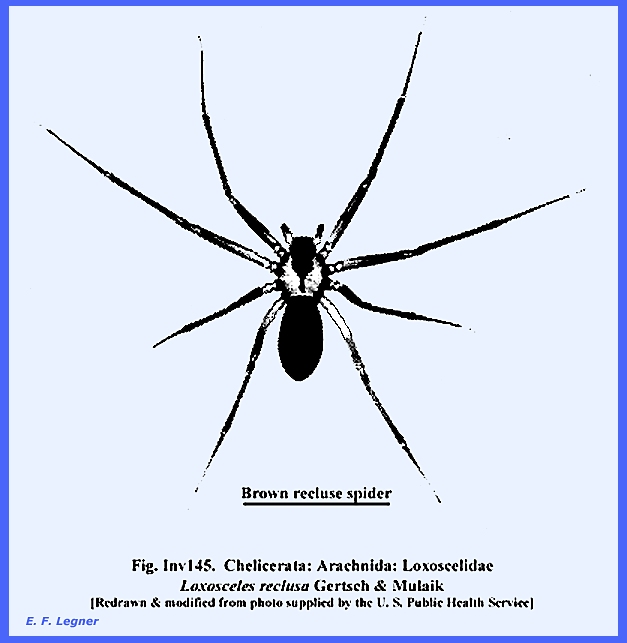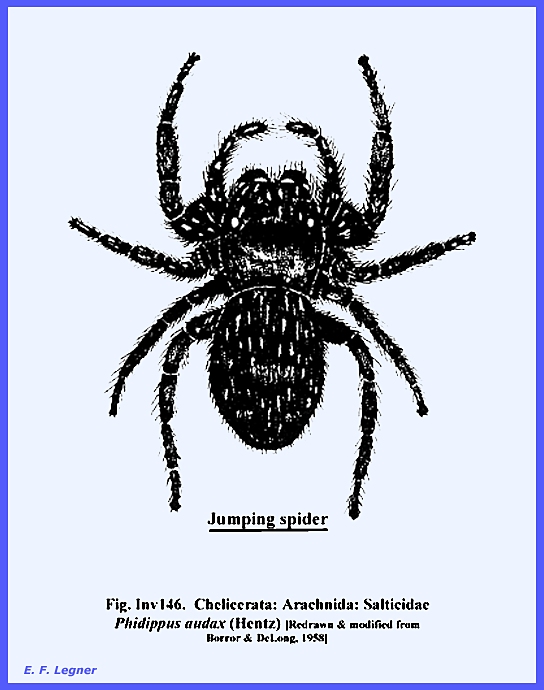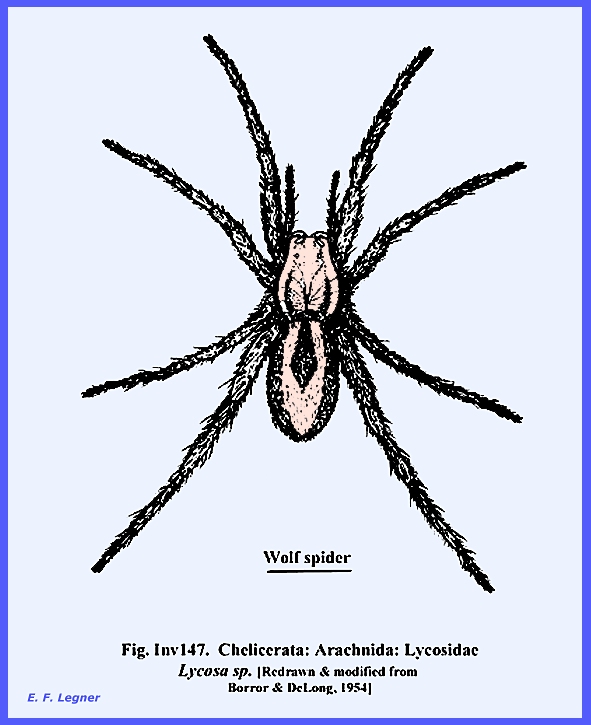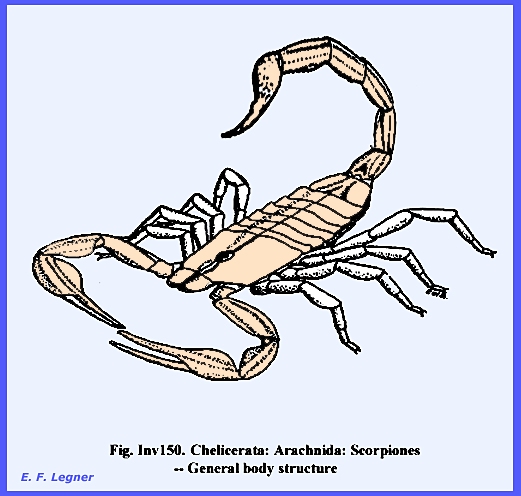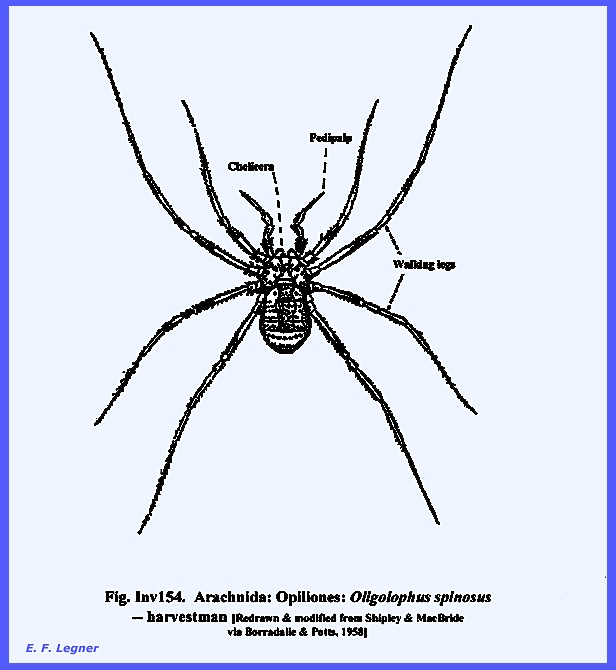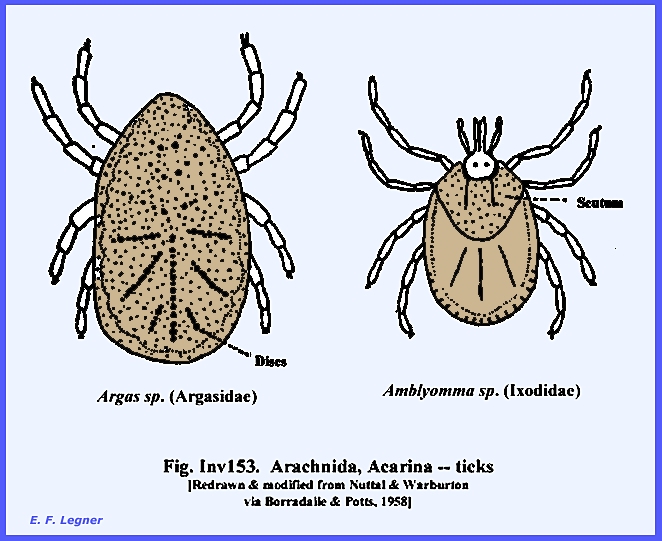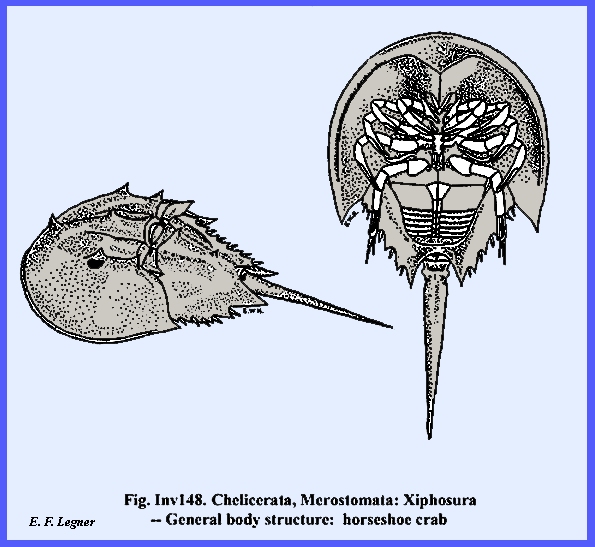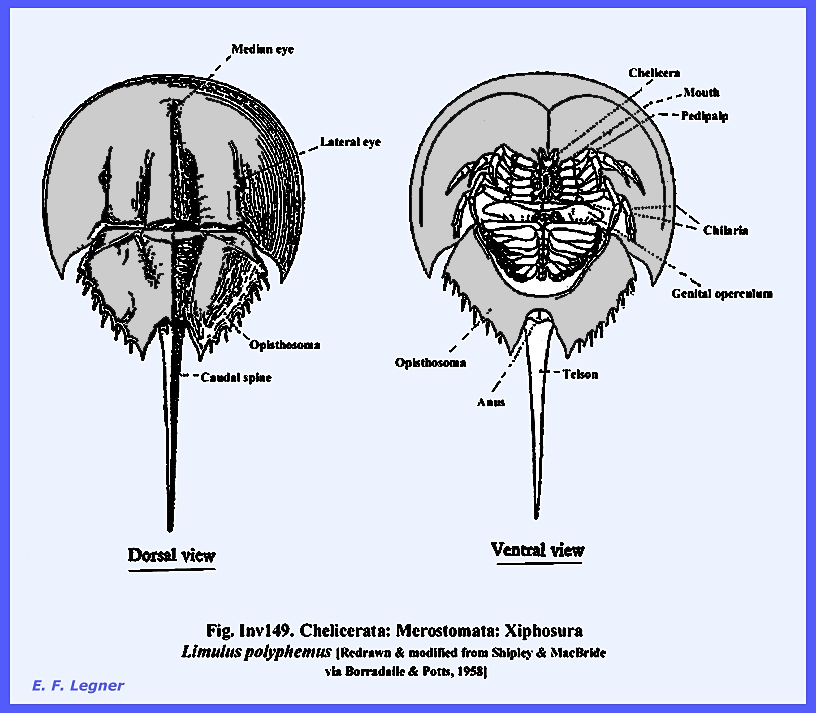File: <chelicerata.htm>
<Index to Invertebrates> <Bibliography> <Glossary> Site Description
<Navigate to Home>
|
Invertebrate
Zoology Kingdom: Animalia, Phylum: Arthropoda, Subphylum: Chelicerata, Classes: Arachnida,
Merostomata & Pycnogonida (Contact)
CLICK on underlined file
names and included illustrations to enlarge: Subphylum:
Chelicerata: The Class Arachnida
includes the spiders, horseshoe crab, scorpions and
mites. It is a very large class of mostly
terrestrial arthropods, with the marine horseshoe crab being an exception. The general characteristics are
the absence of antennae and a body comprised of a cephalothorax and
an abdomen, the latter may appear as only a single part without divisions.
The cephalothorax bears four pair of walking legs and 6-8 eyes raised on
tubercules. The head appendages include chelicerae,
which are jaw like with claws and poison duct openings
at their tips. The basal portion of pedipalps serves
both feeding and sensory functions. ------------------------------------ Class: Arachnida: Order Araneae includes the true
spiders. Segmentation is obscure in
the abdomen and there are no obvious appendages except 3-4 pairs of
spinnerets at the posterior end of the abdomen that are modified abdominal
appendages. Several examples of
spiders may be seen in the following diagrams Inv143 - Inv147: Food
& Digestion -- Insects and other
small animals are caught in webs. The
prey is paralyzed and their liquid contents are moved up through the pharynx and
esophagus. A sucking
stomach
pumps food from the
prey through the mouth and into the digestive tract. Nine diverticulae from the
intestine lead to various body parts.
There is one located forward and four on each side, which function to
increase the surface area. The
posterior part of the intestine is surrounded by digestive glands and some
food may actually enter the glands. A
rectal
caecum
occurs at the junction
of the rectum and intestine. Circulation
-- The heart is long and located in the abdomen. The dorsal aorta in the
cephalothorax has subsequent branches to appendages and the brain and eye
regions. Some blood is pumped
posteriorly to a short posterior aorta. The haemocoel is divided into various
sinuses. Blood reaches the book lungs
and is aerated after which it returns to the heart. Respiration
-- Air diffuses directly into the book lungs, as
the blood does not carry oxygen. Some
tracheae may occur but they are never well developed. Excretion
-- Malpighian tubules serve for excretion.
Coxal glands
that are modified
nephridia may also be involved in excretion. Nervous
System -- There is a typical
pattern where a great concentration of ganglia occurs in the anterior
cephalothorax. Nerves run out to
different parts of the body. Sensory
Organs -- There are the eyes,
pedipalps and setae all over the body all of which have sensory functions. Reproduction
-- The sexes are separate. Ducts open
near the anterior end of the body, but fertilization is internal. Males use pedipalps to transfer sperm from
their genital pore to that of the female.
Eggs are laid in silken cocoons and maternal care is common. Development is direct. Silk Glands --
There are several varieties of silk glands.
The silk they produce differs in strength, slipperiness, etc. Different kinds of webbing are produced
for particular circumstances. The
tips of the legs are modified for walking on the webs. Economic
Importance -- Some species of
spiders are poisonous to humans and animals.
Spider silk has been used in bombsights during World War II. ------------------------------------ Order: Scorpiones (Scorpionida) -- scorpions: These animals have a well marked
cephalothorax and segmented abdomen that is equipped with a sting and poison
gland at the posterior end. They can
be dangerous in warmer regions.
Chelicerae and pedipalps are both chelate. They have book lungs.
They feed on other arthropods.
They are also viviparous as they bear living young. See Inv150 & Inv151 for
examples: ------------------------------------ Order: Amblypygi. (Pedipalpia) --
whip
spiders and tailless whip scorpions: There is a long tail, large palps and
small chelicerae. ------------------------------------ Order: Pseudoscorpionida --
book scorpions:
These are small animals that have the appearance of scorpions because
their pedipalps are pincers. The
abdomen is rounded but without a sting.
They feed on small insects. See Inv152 for example: ------------------------------------ Order: Opiliones (Phalangida)
-- harvestmen: Their extremely long walking legs have
earned them the name of "Daddy Long Legs." The body regions are all compacted into a single
division. They are predators of small
insects and other arachnids. See Inv154 for example: ------------------------------------ Order: Acarina --
mites and ticks: The chelicerae and pedipalps are modified
into projections called a hypostome. They are parasites and vectors of disease,
and serious pests of vegetable and tree crops. See Inv153 for example: ------------------------------------ Class Pycnogonida --
sea spiders:
These are tiny marine animals.
Included are parasites, commensals and free-living predators. ------------------------------------ Class: Merostomata:
Order: Xiphosura --
horseshoe crab:
The range is from the East Coast of North America to the coasts of
southeastern Asia. These animals have
remained essentially unchanged sinde the Paleozoic. They and the Pycnogonida are the only marine arachnids. They are also the only Arachnida with
compound eyes. The chelicerae are
chelate and the pedipalps look like walking legs. But there is four pair of true walking legs. The abdomen has well developed appendages
that have been modified into book gills. Horseshoe crabs are of course a
misnomer as they are not mollusks.
Their blood, which is blue in color, is high in metallic copper and is
harvested regularly for medical research.
See Inv148
& Inv149
for examples: ------------------------------------ Please see
following plates for Example Structures of the Arachnida: Plate 105 = Phylum: Arthropoda, Class:
Arachnida, Order: Pseudoscorpionidea -- Menthus
rossi Plate 106 = Phylum: Arthropoda, Class: Arachnida -- Koenenia sp. & Galeodes arabs ============== |

